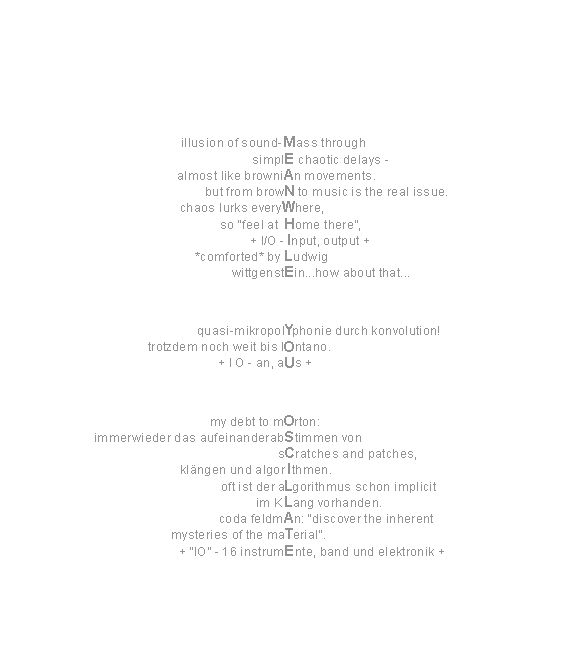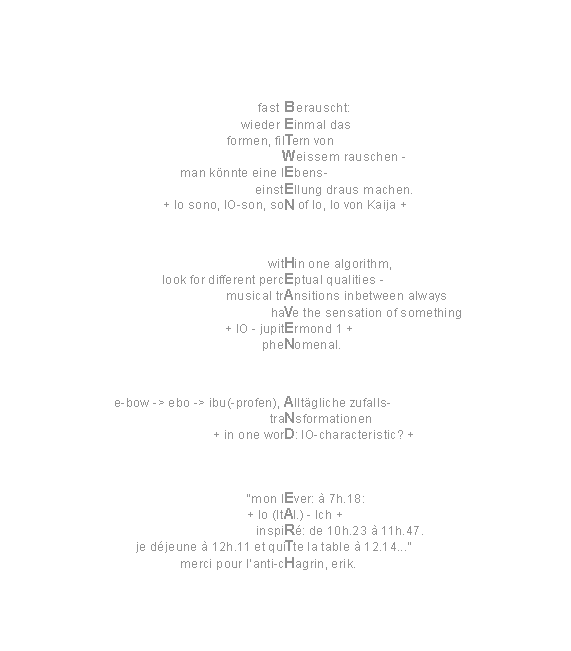writings
- expand_moreMesostics (2006)


- expand_morealiasing bell pattern (2009)Aliasing is a well-kwown term in digital signal processing theory. Simply put, it describes the artefacts that arise when you reduce the sampling frequency, from a standard value like 44,1 kHz. The original signal is then not well represented digitally anymore and mutates.
Because you falsefy the original acoustical signal, aliasing is regarded as an artefact, which should be prevented. Basically, it is regarded as a mistake.
I have discovered a method with which you can apply this "mistake" in a musical, transformative way. You can hear how a rhythmical pattern mutates gradually, away from its original pattern, until it has finally evolved into a completely different sound-phenomenon - a complex, slow changing drone; from a bell sound it transforms into an organ sound and vice versa.It was my intention to explore the different perceptual qualities of that same algorithm/technique, because 'transitions inbeteween always have the sensation of something phenomenal' (Trevor Wishart). Maybe with this piece I was able to go into this direction. - expand_moreCeci n'est pas ma voix (2010)Magritte's central thought behind "Ceci n'est pas une pipe" can be upheld and hopefully enriched, when translating it into sound. Like his pipe was only an image, a reproduction of a real pipe, the voice that is audible is only a digital reproduction of a real voice. Magritte points out that no matter how closely - through realism-art - we come to depicting an item accurately, we never do catch the item itself. When translated into sound the contradiction seems even stronger, because here it is the object itself (my voice) which is stating that it is not the object. Moreover through a sampling rate of 44,1kHz or even higher the depiction of human speech becomes so frighteningly close to the original that you almost can't tell the difference. But still, it is not a human being who speaks to you, but speakers. They are in this case the real sound emitters, not my voice. Encoded information, digital bits, "0s and 1s", are ultimately the source of that speaker emittance, not the larynx and the mouth. To emphasize this thought musically, transformation techniques, such as aliasing and looplength modulation - that become possible in digital and resynthesis domain - are utilized.This multi-lingual, musical Magritte spin-off is structured in three parts:I - "This is not my voice, this is only a digital copy of my voice"In the first part you can hear how, through down-sampling a speech phrase is distorted and transformed slowly into single digital pulses that start to resonate, which gives it a drum-like character. Through the polymetric relationship out of aliasing frequency and the period of the original speech sample new accents and rhythms constantly arise. A second voice is added in canon to the first voice so that the two pulse streams create kind of interlocking figures. Sudden accelerations or decelerations deviate from the pulse and introduce a chaotic element which creates additional rhythmic complexity and tension. Finally the process is mirrored and the pulses transform back into the speech phrase.II - "Ceci n'est pas ma voix, c'est seulement la synthèse de ma voix"In part II a resynthesis of the phrase is divided into many spectral partials. Gradually new groupings of partials evolve. They are manifestations of spectral consonance-dissonance, of spectral orchestration. When a new "partial ensemble" has been established, the highest partial or spectral track is added and the speech phrase becomes intelligible again.III - "Dies ist nicht meine Stimme, es ist nur eine digitale Kopie meiner Stimme"The closing third part was partly inspired by Steve Reichs "come out" - certainly the phasing technique, but also more generally the thought to go from speech to sound, from its semantic meaning to its pure musical, sounding meaning. What might be new is the conscious decision to transform speech (words) into machine-like sounds - this also emphasizes the previous thought. Through a gradual decrease in looplength certain consonants or vowels are isolated and looped. For example, isolating and looping the "o" in "Kopie" accomplishes a kind of motor sound, isolating and looping the "s" in "Dies" creates a steaming engine. At the end the entire machine, its components, phases. This, together with the polyrhythmic mix of all those speech machine sounds, makes the same always sound slightly different.
- expand_moreWhat Was Was (2011), by David BakerWherein an alphabet of surges and shadows bloom like Rorschach indices, clouds of indeterminate origin in a continuous refulgent hierophany, hierophany from the Greek roots "hieros" meaning sacred or holy and "phainein" meaning to reveal or to bring to light."...the true God mimics the universe...debris no longer noticed.. Lurking,the true God literally ambushes reality and us as well... Hence we say, the true God is in the habit of concealing himself... 'Latent form is the master of obvious form.' " - Philip K.Dick, Valis
- expand_moreBeyond the traceries (2020)the english word “tracery” means a.o. “flechtwerk“ in german. one could call the programming structures which i construct for my electronic music ”flechtwerke“ - ”traceries“. however, the resulting music is more than these patches, more than just the algorithm. to a large extent the music depends on how you control it in real time. therefore i found beyond the traceries a fitting title for my new album. it is a phrase quoted from eric pankey's poem epitaph. it inspires the electronic manipulations in the same titled first piece on this album. in this piece it is the deformed language which results from this (time-)stretched phrase that forms white noise. to be more exact, the music results from interactions between two differently stretched phrases and the resulting shifting noise sounds, which permanently and constantly create different combinations. in the pieces called noise bowls the fundamentals and harmonics of two glass bowls - which are, as it were, infinitely changing (in time) - equally produce permanent new combinations. especially the rhythmical,almost infinitely varied interplay of fundamentals and harmonics for me keep these pieces very intruiging from begin- ning to end. the two vibraphone pieces called moving thirds are actually two different takes of the same piece and form the intermezzo between the previously mentioned meditative works. in these pieces, sort of moving thirds - hence the title - are characteristic for the applied harmonic language.in the first phrase it is a minor third, which moves through the chord, so that it first is at the bottom, than in the middle, and finally at the top. as a result a minor/major, a major and a augmented chord emerge. in the second phrase it is a major third, which moves through the chord in the same way and which results in a dominant,a minor and a diminished harmony. in the third phrase elements of these previously mentioned progressions are combined.
- expand_moreKranenburg tree (2021)As the title already indicates, a small tree, which I discovered at the former train station of the small german town Kranenburg (lower rhine area), forms the basis for the music on this album.To be more precise, a photorgraph of this tree, whose musical potential I saw immediately, served as a template for sketches in Metasynth, a software with which you can draw, paint music.This resulted in 4 sketches, consequently the composition has 4 parts.What still fascinates me about this music, is how out of one simple sound (branch) a fairly complex sound structure arises, where fundamentals and partials interfere.Composing the intermezzi for these metasynth main pieces was a real struggle for me as a composer: nothing pleased me, nothing fitted, nothing convinced me. Then eventually the idea came to me to try it simply with silence. This started as an experiment,but then the hearing impression of this music combined with silence convinced me more and more. I made the experience, that in the beginning of the silent tracks the preceding music still resonated. And then at a certain point I started to notice environmental sounds,like heating noise or birdsong, maybe already realizing that absolute silence doesn’t exist - wasn’t it John Cage who discovered that a certain point, maybe in a dead space, you start to hear your own breathing or nervesystem. In my case this is unfortunately enhanced by my tinnitus.
Article Sound Of Music (dutch)
"Schminke fürs Ohr", Article Klaus Hübner (german)
"Harmonien in Zeitlupe", Article Klaus Hübner (german)
"Soms kalm, dan weer donker en verstild", Article Anthony Fiumara (dutch)
Article in Neue Zeitschirft für Musik, Klaus Hübner (german)
Article in Kwadratuur (BEL), Koen van Meel (dutch)
Article in Jazzpodium, Klaus Huebner (german)
Article in Rheinische Post, Barbara Mühlenhoff (german)
Article in Piano Bulletin, Christo Lelie (dutch)
Article in Neue Rhein Zeitung, Andreas Daams (german)
Article in Rheinische Post, Verena Krauledat (german)
Article in Niederrhein Nachrichten, Sigrun Hintzen (german)
Review concert Museum Kurhaus march 1st 2020, Verena Krauledat (german)
"Er macht aus Regentropfen Musik", Article Claudia Gronewald (german)
Florian Wittenburg
Gemeindeweg 55
47533 Kleve
Telefon: + 49(0) 151 74201762
E-Mail: florianwittenburg(at)gmail(dot)com
Gemeindeweg 55
47533 Kleve
Telefon: + 49(0) 151 74201762
E-Mail: florianwittenburg(at)gmail(dot)com